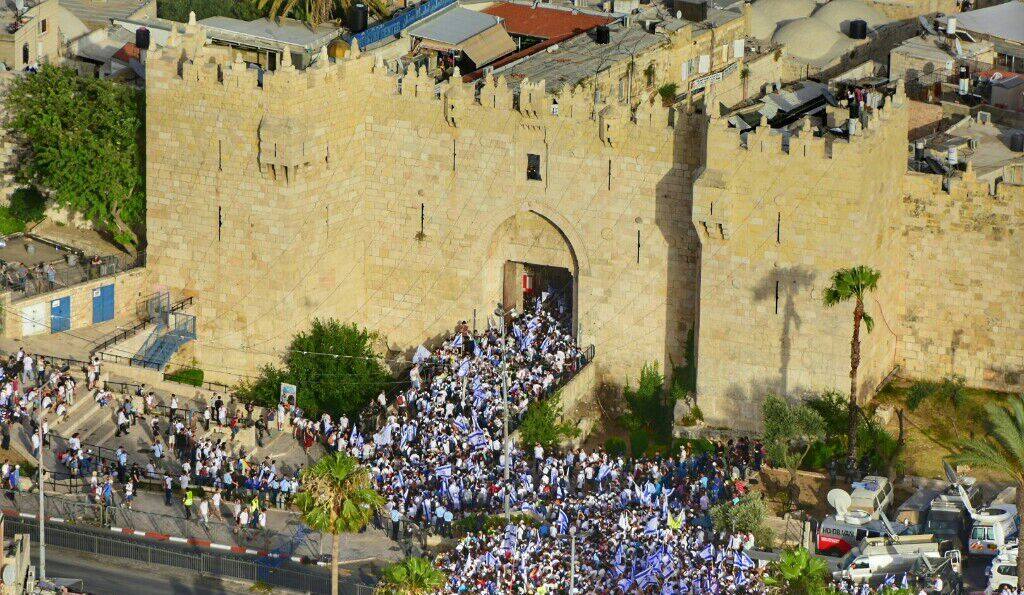Controversial Jerusalem Day Flag March Has Ancient Roots, Historian Says
Flag March celebrates the Israeli capture of east Jerusalem following the 1967 war
Thousands of right-wing revelers are set to march through the streets of Jerusalem’s Old City on Sunday during the annual Flag March.
The march is the central event of Jerusalem Day, which begins at sundown on Saturday and celebrates the Israeli capture of east Jerusalem following the 1967 Arab-Israeli War.
During the parade, marchers will enter the Old City via Damascus Gate and continue through the Muslim Quarter to the Western Wall, waving flags and singing patriotic songs.

Flag parade marchers entering the Old City through Damascus Gate, June 5, 2016. (Israel Police/Wikimedia Commons)
Palestinians have long viewed the parade as a provocation and clashes sometimes occur between marchers and Arab residents of the Old City.
Last year’s march was rerouted due to security concerns amid skyrocketing tensions between Israel and the Palestinians, which saw Hamas fire rockets at the city. This time around, Hamas’s leader Ismail Haniyeh warned that it would respond if the march proceeds as planned, calling the event “Jewish, Talmudic nonsense.”
The roots of the Flag Parade in fact run quite deep in Jewish history, according to Jeffrey Woolf, a professor of Talmud from Bar-Ilan University.
“There is a very long-standing tradition for hundreds of years, possibly for millennia, of walking around and encountering the various gates of Jerusalem and expressing one’s love for Jerusalem,” Woolf told The Media Line. “People would come from all over the world on pilgrimage, walk and say prayers at every single gate, and then they would [similarly] walk around the gates of the Temple Mount.”
Give the gift of hope
We practice what we preach:
accurate, fearless journalism. But we can't do it alone.
- On the ground in Gaza, Syria, Israel, Egypt, Pakistan, and more
- Our program trained more than 100 journalists
- Calling out fake news and reporting real facts
- On the ground in Gaza, Syria, Israel, Egypt, Pakistan, and more
- Our program trained more than 100 journalists
- Calling out fake news and reporting real facts
Join us.
Support The Media Line. Save democracy.


Interestingly, Sunday’s parade also happens on a much smaller scale each month to mark Rosh Hodesh, the beginning of the Jewish month. Known in Hebrew as Sivuv Shearim (Circling of the Gates), during these processions Jews circle the Old City and the Temple Mount from the outside and recite prayers at each gate. The practice was renewed in recent years, but apparently already existed over 1,000 years ago, according to sources found in the Cairo Geniza, an astounding collection of Jewish texts found in the Ben Ezra Synagogue in Old Cairo, Egypt.
Although the Flag Parade has come to be associated with nationalism and in some cases extremism, it was originally not intended to be provocative, Woolf asserted. Rather, it began as a celebration of love for Jerusalem, which occupies a central place in Jewish thought and history.
Heightened political and religious tensions have however transformed the parade into a flashpoint that is at the heart of the Israeli-Palestinian conflict.
“In the past year or so Damascus Gate has become this place where anti-Israel Hamas-sponsored demonstrations have taken place,” Woolf said. “That puts you in an impossible situation because if you don’t go [through there] it’s as if to say that you’re giving up on part of the city. But if you do then it may lead to inappropriate behavior on the part of the marchers or [violence].”
There are currently seven gates that are open and lead into the Old City: Damascus Gate, Herod’s Gate, Jaffa Gate, Lions’ Gate, Dung Gate, Zion Gate, and the New Gate.
Although many marchers will go through Damascus Gate on Sunday, it is customary to also enter the Old City from all the other gates.
“The whole point is to go through all seven gates,” Woolf explained. “This is a very old practice. There are prayers that you say at every gate.”
The custom of parading through the Old City with Israeli flags on Jerusalem Day first appeared in some form a few years after the 1967 war. In the beginning, prominent Religious Zionist leader Rabbi Zvi Yehuda Kook held annual celebratory dinners at Mercaz Harav Yeshiva in Jerusalem (a tradition that still holds to this day). After the dinner would end, attendees would take to the streets and dance on their way to the Western Wall.
“The first year when the victory was still very fresh, they had an assembly in the [Western Wall] plaza,” Woolf affirmed. “They didn’t want to be too ostentatious.”

Flag parade revelers reach the Western Wall in Jerusalem’s Old City, May 22, 2009. (Ron Almog/Wikimedia Commons)
Nowadays the procession is organized by the Am Kalavi foundation and headed by religious Zionist Rabbi Haim Drukman.
Dr. Mordecai Naor, an author and researcher specializing in the history of the state of Israel and the Jewish people, told The Media Line that the traditions of Jerusalem Day have not yet been fully cemented and continue to evolve as the political reality shifts on the ground.
“When it was first celebrated, people would make a pilgrimage to Jerusalem and visit the city,” Naor said. “But the holiday has gotten new [customs].”
According to Naor, the Flag Parade in its current form is a fairly recent addition and is inherently political. Naor, 87, was 13 years old when Israel was founded and does not remember such an event taking place at all in the first years following the reunification of Jerusalem.
“A political organization decided to take advantage of the day,” he said. “If there was a parade then it would go through the Jewish Quarter. Today it purposely makes its way through the Muslim Quarter in order to show who is in charge.”

